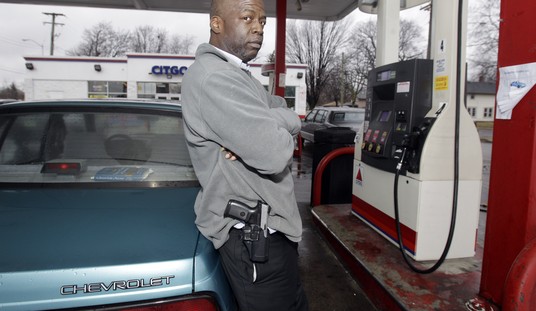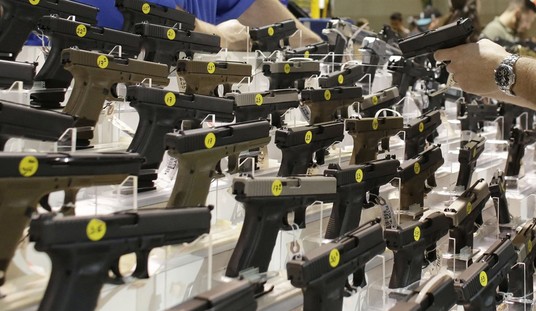Friday saw the release of nine videos by the Chicago Police Department relating to the shooting death of 18-year-old car thief Paul O’Neal as he fled from a car crash he initiated during a high-speed chase.
[Here’s our in-depth analysis of those videos]
O’Neal was spotted with a stolen car. Instead of surrendering at the scene, O’Neal led police on a dangerous high-speed chase through residential neighborhoods where he put the lives of numerous Chicago residents at risk.

O’Neal nearly mowed down one officer at an attempted roadblock (still shot from body camera video from that officer, above), and then crashed the stolen car head-on into a police SUV containing two officers on the next block. O’Neal and a juvenile then fled the stolen car in different directions. The officers in the vehicle hit by O’Neal gave chase after him, and it appears that the officer in the passenger side of the struck SUV is the officer who fired five shots at O’Neal. That officer’s camera was off during the chase and shooting, and he only turned it on afterward.
His body camera video, body camera video #4, begins with him walking back towards other officers after leaving the yard where O’Neal was taken into custody, and gives us insight into his state of mind just after the incident.
It captures him, breathing heavy after the collision, chase, shooting, and cuffing of O’Neal, as he exclaims, “I think I shot that motherf-er.”
The video shows a brief look at the damage to his police SUV from the head-on collision, other cops telling him not to talk about the incident (any decent defensive firearms instructor will give you exactly the same advice; never talk while on an adrenaline spike right after an incident), and shows him walking up a driveway to find his partner, the driver the of impacted Police SUV, who was injured in the crash by who still gave chase.
It was during this moment as he walks up on his partner (starting at moment 2:34 into this video) that we come to understand why the officer using body camera #4 felt compelled to fire on Paul O’Neal.
Officer: “Dude, I, I… are you okay?” {checks on partner, who is doubled over in apparent pain from the crash)
Partner: “Yeah, I’m good man.”
Partner: “Was he shooting at our car?”
Officer: “Dude, I heard shots. I don’t f-king know. When he came out the [unclear) I shot at him.”
Third officer to Partner: “Take your vest off.”
Partner: “I think I’m good man. I dunno. There was a bunch of shots.”
Just off camera, someone motions in a gesture that is only partially captured, and the conversation stops. While I’m only speculating, I’m assuming that the officers were reminded again not to talk about the incident. As they need to be interviewed separately about the incident by investigators, this is good police work.
The two partners part ways and the one with body camera #4 returns to the street, where there is a brief conversation with a supervisor and other officer to determine how many suspects there are, and that they are all in custody.
At six minutes into the video, a supervisor asks who fired, and the officer with body camera #4 confirms, “I fired.”
The supervisor then yells “Hey, Boss!” to someone off camera, and a higher ranking officer walks up and joins the group.
The officer, speaking to another officer reconfirms:
Officer: “I fired, yeah… cause I heard, when we got… we were coming head-on… yeah, I thought my partner was hit back there. I discharged.”
Boss: You discharged? How many you discharged?”
Officer: “Uh… three to five rounds, maybe?”
Boss “Just you? you’re the one who shot?”
Officer: “I heard gunshots coming at us.”
Boss: But you’re the one who shot at the offender?” (pointing towards where Paul O’Neal is down and in custody)
Officer: “Yes, I shot at him.”
Boss” What car were you in?”
Officer: “This car.” (body camera turns slightly presumably as he points)
They then have a brief conversation about another officer shooting, and his injured partner.
The officer mentions that he’s hurt from the crash, and the boss tells the supervisor to stay with the officer. They then go to try to find the officer a place to sit down until EMS comes and the paramedics can check him out.
Before he can sit down, however, another officer (armed with an AR-15) comes over and asks the officer if he can tell him where he fired from so that they can find the shell casings and put down evidence markers.

They then walk to the back yard from where he said he fired to look for the shell casings (above). O’Neal was apparently shot in this yard, cleared the fence (in the distance where you can see two more officers), and collapsed on the far side of that yard around the corner of the house, where he was taken into custody.
The officer then talks a bit more about what he perceived as O’Neal hurtled head-on into his vehicle after another supervisor asked if O’Neal shot at him during the foot chase.
Officer: “The shots were coming at us as the car was coming at us. All I heard was shots. I don’t know if they were firing at us or not. I took off this way. He was coming over this way. when I approached this way I didn’t know if he was armed or not.”

Officer with AR-15: Do you know how many times you fired?”
Officer: “Maybe five? You can check my—”
Supervisor: “Don’t take it out.”
The officer is quiet for a moment and walked toward the fence—presumably to the spot where O’Neal jumped over it as he fled—and it suddenly seems to hit him that he really shot someone.
Officer: “I don’t want nothing to happen to that guy. The way things are going I’m going to get crucified.”
The supervisor tells the officer to settle down and not worry about it and to calm down and try to relax, and the officer inquires as to whether a gun was found in the car. He already knew that a firearm was not not recovered beside O’Neal’s body, as he was one of the officers who took him into custody.
From the video, it is clear that both officers in this vehicle knew shots were fired in their direction just before Paul O’Neal drove his stolen car head-on into their vehicle. They reasonably believed that they had been fired upon as O’Neal used the stolen car as a deadly weapon against them, and reasonably believed that Paul O’Neal was an armed threat.
Tennessee vs. Garner (1985) was a Supreme Court case that defined the limits of when officers could use lethal force against a fleeing suspect (my bold below)
The Tennessee statute is unconstitutional insofar as it authorizes the use of deadly force against, as in this case, an apparently unarmed, nondangerous fleeing suspect; such force may not be used unless necessary to prevent the escape and the officer has probable cause to believe that the suspect poses a significant threat of death or serious physical injury to the officer or others. Pp. 7-22.
Instead of surrendering, Paul O’Neal fled recklessly in his stolen car, nearly ran over an officer attempting to stop him (a still frame from that officer narrowly avoid being murdered by O’Neal is below), and then ran head-on into another police vehicle, seemingly on purpose, as shots were fired.

It is reasonable for the officer using body camera #4 to infer that a suspect who used a car as a weapon twice in a distance of less than 100 yards and who in fact hit him head-on by apparent intent does indeed pose “a significant threat of death or serious physical injury to the officer or others” if he is not brought down with deadly force, especially as he reasonably believed at the time that O’Neal may have a firearm due to the shots that were fired.
Paul O’Neal’s family, their attorney, and activists cry continue to cry that that this was “murder,” but it was not.
The officer who shot and killed Paul O’Neal from behind had legal justification to shoot a dangerous fleeing felon whom he still thought to be a deadly force threat to the community and fellow officers at the time he opened fire.
The only crimes committed during this incident were the two separate incidents within 100 yards where car thief Paul O’Neal attempted to used a car as a weapon against police officers.
Paul O’Neal’s family should be apologizing to the Chicago Police Department for raising such a thoughtless, crime, and violent son, not seeking a payout from the death he brought upon himself through his repeated and continuous criminal actions.








Join the conversation as a VIP Member